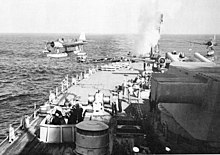Vought OS2U Kingfisher
| OS2U Kingfisher | |
|---|---|
 | |
| General information | |
| Type | Observation floatplane |
| Manufacturer | Vought |
| Primary users | United States Navy |
| Number built | 1,519 |
| History | |
| First flight | 1938 |
| Retired | 1959 (Cuba) |

The Vought OS2U Kingfisher is an American catapult-launched observation floatplane. It was a compact mid-wing monoplane, with a large central float and small stabilizing floats. Performance was modest because of its low-powered engine. The OS2U could also operate on fixed, wheeled, taildragger landing gear.
The OS2U was the main shipboard observation seaplane used by the United States Navy during World War II, and 1,519 of the aircraft were built.[citation needed] It served on battleships and cruisers of the U.S. Navy, with the United States Marine Corps in Marine Scouting Squadron Three (VMS-3), with the United States Coast Guard at coastal air stations; at sea with the Fleet Air Arm of the Royal Navy; with the Soviet Navy; and with the Royal Australian Air Force.
The Naval Aircraft Factory OS2N was the designation of the OS2U-3 aircraft built by the Naval Aircraft Factory in Philadelphia, Pennsylvania. The OS2U first flew on 1 March 1938.[citation needed]
Design and development
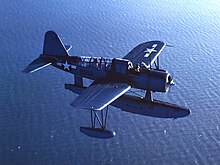
In the late 1930s, Vought engineer Rex Beisel was tasked with designing an observation monoplane aircraft for the U.S. Navy suitable for many tasks, including directing battleship fire. In replacing the standard biplane observation aircraft with a more modern monoplane design, Beisel incorporated innovations making it the first production type to be assembled with spot welding, a process Vought and the Naval Aircraft Factory jointly developed to create a smooth fuselage that resisted buckling and generated less drag. Beisel also introduced high-lift devices and spoilers. In a unique arrangement, deflector plate flaps and drooping ailerons were located on the trailing edge of the wing to increase the camber of the wing and thus create additional lift.[1] Beisel's first prototype flew in 1938, powered by an air-cooled, 450 hp (340 kW) Pratt & Whitney R-985-4 Wasp Junior radial engine.[1]
For combat missions, the pilot had a 0.30 in (7.62 mm) Browning M1919 machine gun, the receiver mounted low in the right front cockpit, firing between the engine cylinder heads, while the radio operator/gunner manned another 0.30 in (7.62 mm) machine gun (or a pair) on a flexible Scarff ring mount. The aircraft could also carry two 100 lb (45 kg) bombs or two 325 lb (147 kg) depth charges.[1][2] Additionally, the "Kingfisher", as it was designated, served as a trainer in both its floatplane and landplane configurations.[3]
Operational history
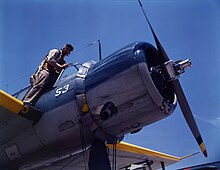

The first 54 Kingfishers were delivered to the U.S. Navy beginning in August 1940, and 6 had been assigned to the Pearl Harbor–based Battle Force before the end of the same year. Many of the following 158 OS2U-2s were attached to flight training at Naval Air Station Pensacola, Florida, but 53 were assigned to equip the newly established Inshore Patrol Squadrons, based at Naval Air Station Jacksonville, Florida. In 1942, nine more Inshore Patrol Squadrons were established, all exclusively equipped with OS2N-1s built by the Naval Aircraft Factory.[4]
The Kingfisher was widely used as a shipboard, catapult-launched scout plane on U.S. Navy battleships, heavy cruisers, and light cruisers during World War II and played a major role in support of shore bombardments and air-sea rescue. Two examples showing the plane's rescue capabilities include the recovery of World War I ace Eddie Rickenbacker and his crew from the Pacific in November 1942[5] and Lieutenant John A. Burns' unique use of the aircraft on 30 April 1944 to taxi airmen rescued from Truk Lagoon to the submarine Tang, which was serving rescue duty near the atoll. In all, Burns rescued ten survivors on two trips[6] and was awarded the Navy Cross for his efforts.
The United States Coast Guard received 76 OS2U-3 Kingfishers starting in 1942 and employed them in anti-submarine warfare, reconnaissance, and search and rescue roles. No Coast Guard Kingfisher is credited with sinking any enemy submarines; however, they were successful in rescuing sailors from ships sunk by enemy torpedoes. The Coast Guard operated Kingfishers until October 1944.[2]
Australia received 18 Kingfishers from a batch of aircraft ordered by the Dutch East Indies that was diverted to Australia in 1942. They were initially used as training aircraft for pilots destined for flying boats, but in 1943 they were used to equip No. 107 Squadron RAAF, which carried out convoy escort duties until disbanded in October 1945.[7] One Kingfisher was used in support of the Australian National Antarctic Research Expedition in 1947–48.[8]
Throughout its U.S. Navy service, the OS2U and even its predecessor, the Curtiss SOC Seagull, served much longer than planned, as the planned successor, the Curtiss SO3C Seamew, suffered from an insufficiently powerful engine which was a complete failure.[9] The OS2U was only slowly replaced in the latter stages of World War II with the introduction of the Curtiss SC Seahawk, the first examples reaching the U.S. Navy in October 1944.[10]
Variants
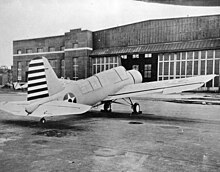
- XOS2U-1
- Prototype Vought Model VS.310 powered by a 450 hp (336 kW) Pratt & Whitney R-985-4 engine, one built.
- OS2U-1
- Initial production variant as the prototype but powered by a 450 hp (336 kW) Pratt & Whitney R-985-48, 54 built.
- OS2U-2
- Production variant with minor equipment changes and powered by a 450 hp (336 kW) Pratt & Whitney R-985-50, 158 built.
- OS2U-3
- Based on the OS2U-2 with self-sealing fuel tanks, armour protection, two 0.30 in (7.62 mm) guns (dorsal and nose mounted), and able to carry 325 lb (147 kg) of depth charges or 100 lb (45 kg) bombs, powered by a 450 hp (336 kW) Pratt & Whitney R-985-AN2 engine, 1006 built.
- OS2U-4
- Two aircraft converted with narrow-chord and high-aspect ratio wings, also fitted with full-span flaps. Not developed.
- OS2N-1
- Naval Aircraft Factory built OS2U-3 with a 450 hp (336 kW) Pratt & Whitney R-985-AN-2 or -AN-8 engine, 300 built.
- Kingfisher I
- British designation for the OS2U-3, 100 delivered to the Royal Navy.
Operators
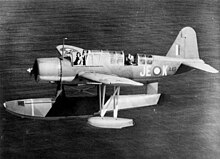

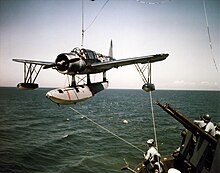
- Operated four aircraft between 1942 and 1959.
 Dominican Republic
Dominican Republic- (Three aircraft)
 Mexico
Mexico
- Six aircraft, 201 Squadron.
 Netherlands
Netherlands- 24 aircraft, not delivered in time for hostilities.
 Soviet Union
Soviet Union
- 2 aircraft on the ship USS Milwaukee (Murmansk)
 United Kingdom
United Kingdom
- Received 100 aircraft.
 United States
United States
- Received six OS2U-3s in 1942 to 1959 under Lend Lease.[11]
Aircraft on display


At least eight Kingfishers survive in collections of historic aircraft around the world.[12]
Australia
- OS2U-3
- 5985 – Whale World, Albany, Western Australia. It is waiting to be restored. Originally built for the Netherlands Navy in the Dutch East Indies, it was transferred to the RAAF in 1942, serving with Seaplane Training Flight (later 3 OTU) and 107 Sqn before being sold as war surplus in 1945.[13] Now with Pioneer Aero Ardmore New Zealand for restoration, see below.
Chile
- OS2U-3
Cuba
- OS2U-3
- 09650 (marked #50) – Museum of the Revolution (Museo de la Revolución), Havana, Cuba. It is fitted with fixed landing gear rather than a float.[15]
New Zealand
- OS2U-3
- 5985 – Pioneer Aero, Auckland, New Zealand. Currently undergoing restoration. Originally built for Netherlands Navy in Dutch East Indies, it was transferred to the RAAF in 1942, serving with Seaplane Training Flight (later 3 OTU) and 107 Sqn before being sold as war surplus in 1945.[16]
- 5982- Pioneer Aero, Auckland, New Zealand. Currently in Storage for future restoration.
United States
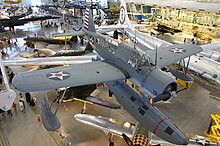
- On display
- OS2U-3
- 1368 (marked #60, painted as 0951) – Obtained from Mexico, the aircraft was previously displayed aboard the battleship Alabama and is now displayed inside the aircraft pavilion adjacent to the battleship in Mobile, Alabama. The building and the aircraft sustained some damage from Hurricane Katrina in 2005.[17]
- 5909 – Boeing Aviation Hangar at the Steven F. Udvar-Hazy Center, National Air and Space Museum at Dulles International Airport outside of Washington, DC.[18]

Kingfisher donated by Lynn Garrison to North Carolina Battleship Commission - 5926 – National Naval Aviation Museum at NAS Pensacola, Florida. It was one of six OS2U-3 Kingfishers that were transferred by Lend-Lease to the National Navy of Uruguay during World War II. This aircraft operated as a seaplane until 1958 and was obtained in 1971.[19]
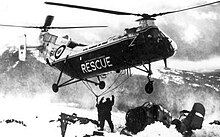
- 3073 (marked #8 based on assigned air group) – On board the battleship North Carolina in Wilmington, North Carolina. With the assistance of a Royal Canadian Air Force Piasecki helicopter, Lynn Garrison salvaged this Kingfisher from Calvert Island (British Columbia), during the winter of 1963. It crashed there on a ferry flight to Alaska during World War II. It was initially restored for display by volunteers at Vought Aeronautics in Grand Prairie, Texas[20] and sent to the battleship in 1971. The 2018 restoration of the Kingfisher was managed by a Wilmington resident and the Carolina Chapter of the Flight Deck Veterans Group.[citation needed]
- In storage
- OS2U-3
- 09643 – In storage at the Yanks Air Museum, Chino, California.[21][22]
Specifications (OS2U-3)
Data from Jane's Fighting aircraft of World War II[23]
General characteristics
- Crew: 2
- Length: 33 ft 7.2 in (10.241 m)
- Wingspan: 35 ft 10.7 in (10.940 m)
- Height: 14 ft 8 in (4.47 m)
- Wing area: 261.9 sq ft (24.33 m2)
- Airfoil: root: NACA 23015; tip: NACA 23009[24]
- Empty weight: 3,335 lb (1,513 kg)
- Gross weight: 4,980 lb (2,259 kg)
- Max takeoff weight: 6,000 lb (2,722 kg)
- Fuel capacity: 144 US gal (120 imp gal; 545 L) in an integral wing tank
- Powerplant: 1 × Pratt & Whitney R-985-AN2 Wasp Junior 9-cylinder air-cooled radial piston engine, 450 hp (340 kW) for take-off
- 400 hp (300 kW) at 5,000 ft (1,500 m)
- Propellers: 2-bladed Hamilton Standard constant-speed propeller
Performance
- Maximum speed: 171 mph (275 km/h, 149 kn) at 5,000 ft (1,500 m)
- Cruise speed: 152 mph (245 km/h, 132 kn) with 75% power at 6,000 ft (1,800 m)
- Landing speed: 55 mph (48 kn; 89 km/h)
- Range: 908 mi (1,461 km, 789 nmi) with 75% power at 6,000 ft (1,800 m)
- Service ceiling: 18,200 ft (5,500 m)
- Rate of climb: 960 ft/min (4.9 m/s) at 4,000 ft (1,200 m)
- Wing loading: 19 lb/sq ft (93 kg/m2)
- Power/mass: 0.08 hp/lb (0.13 kW/kg)
Armament
- Guns: One fixed, forward firing .30 in (7.62 mm) M1919 Browning machine gun with 500 rounds and one .30 in (7.62 mm) M1919 Browning machine gun with 600 rounds, flexibly mounted for the observer.
- Bombs: 650 lb (295 kg) of bombs or depth charges.[2]
See also
Aircraft of comparable role, configuration, and era
- Aichi E13A
- Arado Ar 196
- Curtiss SOC Seagull
- Curtiss SO3C Seamew
- Curtiss SC Seahawk
- IMAM Ro.43
- Mitsubishi F1M
- Edo OSE
- Stearman XOSS
Related lists
Notes
- ^ a b c Noles Jr., James (February–March 2005). "Old, slow and ugly" (PDF). Air and Space. p. 66. Archived from the original (PDF) on 7 September 2008.
- ^ a b c d "Vought OS2U-2 / 3 "Kingfisher"". Coast Guard Aviation Association. United States Coast Guard Aviation History. Archived from the original on 14 August 2024. Retrieved 7 January 2023.
- ^ Hickman 2010, p. 59.
- ^ Bowers 1990, p. 447.
- ^ Doll and Jackson 1975, pp. 122–123
- ^ Doll and Jackson 1975, pp.123, 127.
- ^ Vincent 1998, pp. 54–59.
- ^ Vincent 1998, pp. 61–62.
- ^ Bowers 1990, p. 164.
- ^ Bowers 1990, p. 169.
- ^ Steinemann Air International February 1992, p. 73.
- ^ "Vought OS2U (Kingfisher)". Aviation Enthusiast Corner. Archived from the original on 3 April 2012. Retrieved 12 January 2011.
- ^ "OS2U-3 Kingfisher/5985 in Australia". airliners.net. Archived from the original on 25 May 2011. Retrieved 12 January 2011.
- ^ "OS2U-3 Kingfisher/5925 in Chile". museoaeronautico.cl (in Spanish). Archived from the original on 17 June 2008. Retrieved 12 January 2011.
- ^ "OS2U-3 Kingfisher/Unknown in Cuba". airliners.net. Archived from the original on 7 November 2012. Retrieved 12 January 2011.
- ^ "Vought OSU Kingfisher". pioneeraero.co.nz. 28 April 2015. Archived from the original on 6 April 2017. Retrieved 5 April 2017.
- ^ "OS2U-3 Kingfisher/1368". USS Alabama Museum. Archived from the original on 4 September 2012. Retrieved 13 June 2012.
- ^ "OS2U-3 Kingfisher/5909". NASM. Archived from the original on 2 April 2011. Retrieved 12 January 2011.
- ^ "OS2U-3 Kingfisher/5926". National Museum of Naval Aviation. Archived from the original on 9 April 2012. Retrieved 12 January 2011.
- ^ "OS2U-3 Kingfisher/Unknown at USS North Carolina". battleshipnc.com. Archived from the original on 12 January 2011. Retrieved 12 January 2011.
- ^ "Vought OS2U-3 Kingfisher". Yanks Air Museum. Archived from the original on 30 October 2020. Retrieved 6 October 2018.
- ^ "Airframe Dossier". Aerial Visuals. Archived from the original on 6 October 2018. Retrieved 6 October 2018.
- ^ Bridgman, Leonard, ed. (1989). Jane's Fighting aircraft of World War II (1995 ed.). New York: Military Press. p. 214. ISBN 0517679647.
- ^ Lednicer, David. "The Incomplete Guide to Airfoil Usage". m-selig.ae.illinois.edu. Archived from the original on 26 March 2019. Retrieved 16 April 2019.
References
- Adcock, Al (1991). OS2U Kingfisher in Action (Aircraft in Action No. 119). Carrollton, TX: Squadron/Signal Publications. ISBN 0-89747-270-5.
- Bowers, Peter M. (1990). United States Navy Aircraft since 1911. Annapolis, MD: Naval Institute Press. pp. 447–448. ISBN 0-87021-792-5.
- Doll, Thomas E.; Jackson, Berkley R. (1974). Vought-Sikorsky OS2U Kingfisher. Aircraft in Profile. Vol. 14. Windsor, Berkshire, UK: Profile Publications. pp. 113–136. ISBN 0-85383-023-1.
- Eden, Paul; Moeng, Soph, eds. (2002). The Complete Encyclopedia of World Aircraft. London: Amber Books. ISBN 0-7607-3432-1.
- Hickman, Patrick M. (2010). The Aircraft Collection. Pensacola, FL: The Naval Aviation Museum Foundation.
- Lawrence, Joseph (1945). The Observer's Book Of Airplanes. London and New York: Frederick Warne & Co.
- Pattison, Barry (1998). Kingfisher in the Antipodes. Melbourne, Victoria: Red Roo Models.
- Steinemann, Peter (February 1992). "Protector of the Plate". Air International. Vol. 42, no. 2. pp. 73–78. ISSN 0306-5634.
- Sturtivant, Ray; Burrow, Mick (1995). Fleet Air Arm Aircraft: 1939 to 1945. Tonbridge, Kent, UK: Air Britain (Historians). ISBN 0-85130-232-7.
- Vincent, David (September–October 1998). "Kangaroo Kingfishers". Air Enthusiast. No. 77. Stamford, UK: Key Publishing. pp. 54–62. ISSN 0143-5450.

